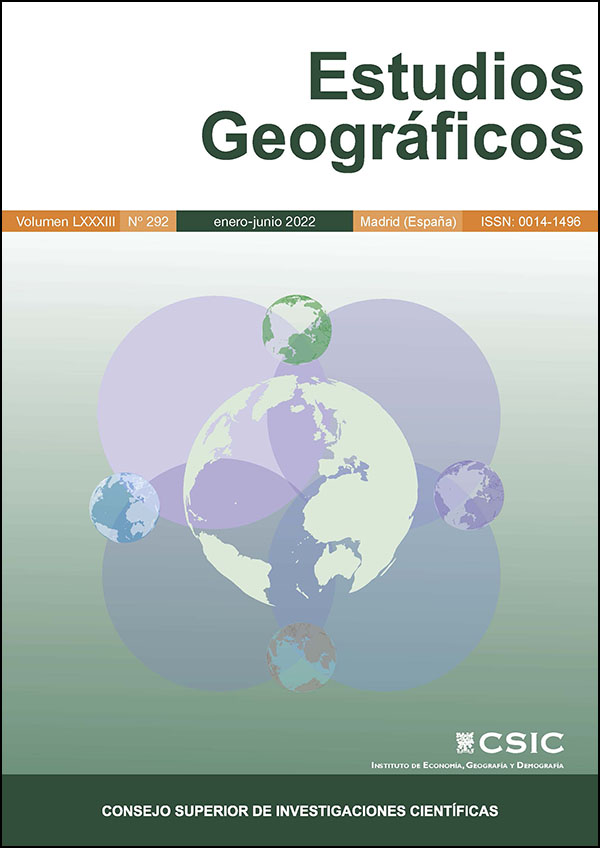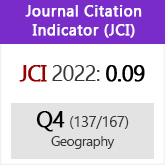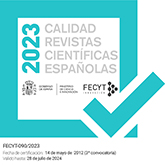Riverside poplar plantations. Analysis from a historical and hydraulic perspective of the banks of the river Carrión
DOI:
https://doi.org/10.3989/estgeogr.2022124.124Keywords:
Forest resources, forestry crops, poplar, hydraulic public domain, hydrological planning, riverbanksAbstract
Poplar plantations on the banks of Spanish rivers are in question. The Duero Hydrological Confederation has prohibited the establishment of poplar groves on the banks of the rivers in the Duero Basin, because they are located in what the Water Law considers a watercourse and public hydraulic domain. This situation implies that most of the current poplar crops on the river banks, such as those of the Carrión River, in Palencia Province, should not exist, and new plantation of poplar trees should not be promoted. This circumstance very negatively affects several towns that get significant economic resources from the traditional use of these productive forest crops. In this article, we try to demonstrate by means of historical evidence, based on aerial photography, documents and scientific and ancient references, that poplar crops, in addition to their productive function, have an important effect on: recovering old degraded riverbanks, setting the unstable riverbeds, improving hydraulic flow conditions for flood control, protecting banks against erosion, and regenerating the riparian and fluvial ecosystem that, from ancient time until the begining of the 20th century, were destroyed by human overexploitation.
Downloads
References
Allegro, G. y Sciaky, R. (2003). Assessing the potential role of ground beetles (Coleoptera, Carabidae) as bioindicators in poplar stands, with a newly proposed ecological index (FAI). Forest Ecology and Management, 175 (1-3): 275-284. https://doi.org/10.1016/S0378-1127(02)00135-4
Ayerbe, J.M. (1928). Proyecto de repoblación y fijación del álveo del río Carrión. Provincia de Palencia. Documento n.1: Memoria. Confederación Sindical Hidrográfica del Duero. Servicio Forestal. Archivo de la Confederación Hidrográfica del Duero: Valladolid
Ayerbe, J.M. (1930). Proyecto de restauración y repoblación de las laderas de la margen izquierda del río Carrión. Memoria y presupuesto. Archivo de la Confederación Hidrográfica del Duero: Valladolid
Azcarretazábal, D. (1963). Proyecto de repoblación forestal, restauración de laderas y consolidación de márgenes en el río Carrión. Memoria y presupuesto. Archivo de la Confederación Hidrográfica del Duero: Valladolid.
Bauer, E. (1991). Los montes de España en la historia. Fundación Conde del Valle de Salazar. Madrid. 613 p.
Broadmeadow, S. y Nisbet, T. R. (2004). The effects of riparian forest management on the freshwater environment: a literature review of best management practice. Hydrology and Earth System Sciences Discussions, European Geosciences Union, 8 (3): 286-305. https://doi.org/10.5194/hess-8-286-2004
Bunn, S.E., Davies, P.M., Kellaway, D.M. y Prosser, I.P. (1998). Influence of invasive macrophytes on channel morphology and hydrology in an open tropical lowland stream, and potential control by riparian shading. Freshwater Biology, 39: 171-178 https://doi.org/10.1046/j.1365-2427.1998.00264.x
Carro, P. (2020). La Junta subastó 7.200 metros cúbicos de madera de chopo en Burgos en 2019, el 77% del total regional. BURGOSconecta. Recuperado de https://www.burgosconecta.es/provincia/junta-subasto-7200-20200817193148-nt.html?ref=https%3A%2F%2Fwww.google.com%2F
CHD. (2020). Esquema provisional de Temas Importantes (EpTI) del tercer ciclo de planificación: 2021-2027. Recuperado en Chrome-extension: https://www.chduero.es/documents/20126/1213596/EPTI+tercer+ciclo_07_DHDuero_version19012020.pdf/1f20907a-6056-f489-a324-ae02aff2f5f0?t=1579699889054
Chow, V.T. (1959). Open-channel hydraulics. International student edition.McGraw-Hill Civil Engineering Series. McGraw-Hill: Tokyo. xviii, 680 pp.
Cole, L.J., Stockanb, J. y Helliwell, R. (2020). Managing riparian buffer strips to optimise ecosystem services: A review. Agriculture, Ecosystems and Environment, 296. https://doi.org/10.1016/j.agee.2020.106891
Dawson, F.H. y Kern-Hansen, U. (1979). The effect of natural and artificial shade on the macrophytes of lowland streams and the use of shade as a management technique. Hidrobiology, 64 (4): 437-455 https://doi.org/10.1002/iroh.19790640402
DOCE. (2000). Directiva Marco Europea del Agua, 2000/60/CE. Diario Oficial de las Comunidades Europeas, 22 de Diciembre de 2000. 72 p.
Evangelista, H., Michelan, T.S., Gomes, L.C. y Thomaz, S.M. (2017). Shade provided by riparian plants and biotic resistance by macrophytes reduce the establishment of an invasive Poaceae. Journal of Applied Ecology, 54: 648-656. https://doi.org/10.1111/1365-2664.12791
Fernández, S. y Mata, R. (2000). Pasado y presente de las repoblaciones forestales en montes de sociedades de vecinos. Estudios Geográficos, LXI, 240: 461-486.
Fernández Yuste, J.A. (2018). Riberas y choperas: del conflicto a la oportunidad, en Libro de Actas del II Simposio del Chopo. Ed: Sociedad Pública de Infraestructuras y Medio Ambiente de Castilla y León S.A. Valladolid: 145-156
Forzieri, G., Castelli F. y Preti, F. (2012). Advances in remote sensing of hydraulic roughness, International Journal of Remote Sensing, 33,2: 630-654. https://doi.org/10.1080/01431161.2010.531788
García Pérez, R. (2018). Superficie repoblada con chopo de producción en Castilla y León, en Libro de Actas del II Simposio del Chopo. Ed: Sociedad Pública de Infraestructuras y Medio Ambiente de Castilla y León S.A. Valladolid: 365-379
Gil, L. (2011). El bosque que nos ha llegado: la extinción local de los bosques en España, en Ezquerra, F.J. y Rey, E. (2011) La evolución del paisaje vegetal y el uso del fuego en la cordillera Cantábrica. Fundación Patrimonio Natural de Castilla y León, Valladolid.
González del Tánago, M. y García de Jalón, D. (2006). Attributes for assessing the environmental quality of riparian zones. Limnetica, 25(1-2): 389-402. https://doi.org/10.23818/limn.25.27
González, E., Masip, A. y Tabacchi, E. (2016). Poplar plantations along regulated rivers may resemble riparian forests after abandonment: a comparison of passive restoration approaches. Restoration Ecology, 24 (4): 538-547. https://doi.org/10.1111/rec.12351
González del Tánago, M.; Martínez-Fernández, V.; Rincón, Gonzalo y García de Jalón, D. (2019). Estrategia de Restauración de Ríos a escala regional: Propuesta metodológica y aplicación a los ríos de la Comunidad de Madrid. Restaura Ríos. III Congreso de Restauración de Ríos. Murcia.
Hopfner, H. (1954). La evolución de los bosques de Castilla la Vieja en tiempos históricos. Estudios Geográficos, 1: 415-430
Hughes, F.M.R., González del Tánago, M. y Owen, J. (2012). Restoring Floodplain Forests in Europe. En J. Stanturf et al. (eds.), A Goal-Oriented Approach to Forest Landscape Restoration, World Forests 16: 393-422. https://doi.org/10.1007/978-94-007-5338-9_15
Isebrands, J.G. y Richardson, J. (Eds.) (2014). Poplars and willows: Trees for Society and the Environment. Food and Agriculture Organization. FAO. CABI. UK. https://doi.org/10.1079/9781780641089.0000
Kiss, T., Nagy, J., Fehérváry, I. y Vaszkó, C. (2019). (Mis) management of floodplain vegetation: The effect of invasive species on vegetation roughness and flood levels. Science of the Total Environment, 686: 931-945. https://doi.org/10.1016/j.scitotenv.2019.06.006 PMid:31200311
Lalanda, P. (1975). Las Vegas de Saldaña y Carrión, antecedentes históricos de sus regadíos. Publicaciones de la Institución Tello Téllez de Meneses, 36: 141-205.
Li, Y., Chen, X., Xie, Y., Li, X., Li, F. y Hou, Z. (2015). Effects of young poplar plantations on understory plant diversity in the Dongting Lake wetlands, China. Scientific Reports, 4, 6339. https://doi.org/10.1038/srep06339 PMid:25208975 PMCid:PMC4160706
López-Covarrubias, D. y Díaz Balteiro, L. (2018). Turno óptimo y rentabilidad en las choperas de Castilla y León y de La Rioja. En Libro de Actas del II Simposio del Chopo. Ed: Sociedad Pública de Infraestructuras y Medio Ambiente de Castilla y León S.A. Valladolid: 381-388
Lowrance, R., Altier, L.S., Denis, J., Schnabel, R.R., Groffman, P.M., Denver J.M., Correll, D., Wendell, J., Robinson, J.L., Brinsfield, R.B., Staver, K.W., Lucas, W. y Todd, A.H. (1997). Water Quality Functions of Riparian Forest Buffers in Chesapeake Bay Watersheds. Environmental Management, 21 (5): 687-712 https://doi.org/10.1007/s002679900060 PMid:9236284
Macho, A. (1907). El paludismo y la deforestación de los montes son la ruina de Castilla. Conferencia dictada en el VI Congreso de la Federación Agrícola de Castilla La Vieja. Palencia. 52 p.
Martín-García, J., Barbaro, L., Diez, J.J. y Jactel, H. (2013). Contribution of poplar plantations to bird conservation in riparian landscapes. Silva Fennica, Suomen Metsätieteellinen Seura ry, 47 (4), 17 p. DOI: ⟨10.14214/sf.1043⟩. ⟨hal-02645533⟩ https://doi.org/10.14214/sf.1043
Mínguez, J.L. y Jubete, F. (1987). Introducción a la ecología de las riberas del río Carrión, en los términos municipales de Palencia, Grijota, Husillos y Monzón de Campos. Tabanque, 3: 153-207
MITECO. (2022). Delimitación del Dominio Público Hidráulico: el Proyecto Linde. Recuperado en https://www.miteco.gob.es/es/agua/temas/delimitacion-y-restauracion-del-dominio-publico-hidraulico/delimitacion-dph-proyecto-linde/
Mola, A. (1896). De las orillas de nuestros ríos. Revista Montes, 476: 533-536
Molina, P. y Berrocal, A.B. (2013). Dinámica fluvial, propiedad de la tierra y conservación del paisaje de ribera en el entorno de Aranjuez (Madrid, Toledo). Estudios Geográficos, LXXIV, 275: 495-522. https://doi.org/10.3989/estgeogr.201318
Peribáñez, J.G. (2018). El medio natural de la Ribera del Duero en época medieval y moderna. IES Cabo de la Huerta, Alicante. ISSN 1132-225X, Nº. 33.
Piegay H. y Bravard, J.P. (1997). Response of a Mediterranean riparian forest to a 1 in 400 year flood, Ouveze River, Drome-Vaucluse, France. Earth Surface Processes and Landforms, 22: 31-43 https://doi.org/10.1002/(SICI)1096-9837(199701)22:1<31::AID-ESP677>3.0.CO;2-#
Regueras, J.I. (2001). Choperas y biodiversidad. En I Simposio del Chopo. Asociación Española de Ecología Terrestre y UPNA (org.), 49-56. Recuperado en https://pfcyl.es/evento/simposio-del-chopo
Rodríguez, I. y Ruiz, V. (2001). Avifauna nidificante asociada a bosques de ribera y choperas de repoblación, próximas a cauces fluviales, en la provincia de León. En I Simposio del Chopo. Asociación Española de Ecología Terrestre y UPNA (org.), 57-65. Recuperado en https://pfcyl.es/evento/simposio-del-chopo
Sender, J. (2016). Applied Ecology and Environmental Research.
Steiger, J. Tabacchi, E., Dufour, S., Corenblit, D. y Peiry, J.L. (2005). Hydrogeomorphic processes affecting riparian habitat within alluvial channel-floodplain river systems: a review for theTemperate zone. River Research and Applications, 21: 719-737. https://doi.org/10.1002/rra.879
Tabacchi, E. y Planty-Tabacchi, A.M. (2003). Recent changes in riparian vegetation: possible consequences on dead wood processing along rivers. River Research and Applications, 19: 251-263. https://doi.org/10.1002/rra.755
Ulrich, W., Buszko, J. y Czarnecki, A. (2004).The contribution of poplar plantations to regional diversity of ground beetles (Coleoptera: Carabidae) in agricultural landscapes. Annales Zoologici Fennici, 41 (3): 501-512.
Ventura, M., Ribas, A. y Saurí, D. (2002). Dos discursos antagónicos a la gestión integral de los ríos: el río antropocéntrico versus el río ecocéntrico. Estudios Geográficos, LXIII, 246: 119-141. https://doi.org/10.3989/egeogr.2002.i246.263
Published
How to Cite
Issue
Section
License
Copyright (c) 2022 Consejo Superior de Investigaciones Científicas (CSIC)

This work is licensed under a Creative Commons Attribution 4.0 International License.
© CSIC. Manuscripts published in both the printed and online versions of this Journal are the property of Consejo Superior de Investigaciones Científicas, and quoting this source is a requirement for any partial or full reproduction.All contents of this electronic edition, except where otherwise noted, are distributed under a “Creative Commons Attribution 4.0 International” (CC BY 4.0) License. You may read here the basic information and the legal text of the license. The indication of the CC BY 4.0 License must be expressly stated in this way when necessary.
Self-archiving in repositories, personal webpages or similar, of any version other than the published by the Editor, is not allowed.
















